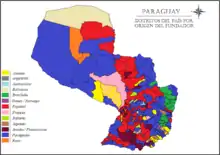Immigration to Paraguay
Historically, the migratory history of Paraguay has been ambiguous, since it has had periods of large scale emigration as well as large waves of immigrants, primarily from Europe.[1]

Ethnically, Paraguay considers itself as a white and mestizo country, the result of intermarriage between Amerindians (mainly Guaraní) and Europeans (mostly of Spanish origin). Unlike neighbouring countries like Argentina or Brazil, Paraguay did not attract massive numbers of immigrants, but this does not imply that it has not been a recipient thereof. However, during the 19th century the country suffered a devastating war that greatly reduced its population, having to rise from the ashes and repopulate their territory with the help of immigrants.
During the 20th century, Paraguay became a recipient of immigrants, especially Europeans fleeing wars occurring in the Old World, in search of a better life and peace. Among European groups in the country, this includes those of Spanish, German (many of them being Mennonites), Italian, French and Slavic origin. Other groups included these of Levantine/Arabs roots (mostly Christian Lebanese and Syrians) and East Asians (such as the Chinese and Japanese), among others.[2]
Today, immigration to Paraguay has not ceased, but the places of origin of the newcomers have changed. According to the 2002 census, 84,2% of immigrants in Paraguay come from Brazil and Argentina.[3]
History
The first Europeans to arrive in what is now Paraguayan territory were Spaniards who left a palpable cultural heritage even today.
The government of Carlos Antonio López was marked by a period of international openness including immigration and attracting settlers to populate the country.
Settlement in the Paraguayan Chaco



Geographically, Paraguay can be divided into two parts: The Chaco or Western Region, and the Eastern Region, where Asunción is located, as well as the other main cities of the country.
The Chaco is the largest region by area with about 60% of the total territory but, on the other hand, it is the least populated region being home to less than 2% of the total population. Because of this, one of the main goals of the government of Paraguay was to populate this vast and immense region, which comprises the departments of Presidente Hayes, Boquerón, and Alto Paraguay (also known in English as Upper Paraguay).
The colonisation of the Chaco began with the founding of several colonies, including Nueva Burdeos (French: Nouvelle-Bordeaux, present-day Villa Hayes), which was founded by French immigrants. The first settlers came to this colony through the port of Asunción in 1856.[4] In the years 1927, 1930 and 1947, three waves of German speaking Mennonites who formed Russia came from Canada and the Soviet Union to the Chaco and started three colonies there. In the 2020s about a third of the Chaco population belongs to these Chaco Mennonites who are an important part of the population of Mennonites in Paraguay.[5]
Figures
The table below obviously only shows the official numbers in individual immigrants. Most of the often German Brasiguayos, who came as early as around the year 1900 are not included. Also some 8,300 German speaking Mennonites who came from Canada in 1927 (1,778 people) and from Russia in 1930 and 1932 (ca. 2,000) and in 1947 (ca. 4,500 via Germany) are not in the table.[6]
| Place of origin | 1870-1879 | 1880-1889 | 1890-1899 | 1900-1909 | 1910-1919 | 1920-1929 | 1930-1939 | 1940-1949 | 1950-1959 |
|---|---|---|---|---|---|---|---|---|---|
| Paraguayan returnees | 0 | 0 | 0 | 51 | 193 | 105 | 111 | 0 | 0 |
| Argentina | 0 | 4.895 | 18 | 364 | 1.122 | 100 | 141 | 512 | 2.036 |
| Brazil | 0 | 530 | 0 | 29 | 44 | 0 | 12 | 77 | 474 |
| Uruguay | 0 | 198 | 0 | 59 | 68 | 40 | 12 | 43 | 188 |
| Bolivia | 0 | 0 | 0 | 4 | 0 | 0 | 8 | 13 | 75 |
| United States | 0 | 0 | 6 | 37 | 3 | 35 | 9 | 60 | 385 |
| Canada | 0 | 0 | 0 | 0 | 0 | 1 | 0 | 20 | 99 |
| Rest of the Americas | 0 | 0 | 0 | 2 | 4 | 0 | 5 | 36 | 136 |
| Total from the Americas | 0 | 5.623 | 24 | 546 | 1.434 | 281 | 298 | 671 | 3.393 |
| Italy | 0 | 824 | 251 | 1.115 | 973 | 37 | 41 | 238 | 580 |
| Spain | 0 | 321 | 9 | 809 | 1.494 | 37 | 73 | 159 | 1.287 |
| France | 0 | 228 | 10 | 124 | 111 | 15 | 109 | 63 | 148 |
| Germany | 0 | 467 | 11 | 479 | 811 | 814 | 1.038 | 186 | 661 |
| United Kingdom | 800 | 39 | 28 | 35 | 31 | 9 | 8 | 84 | 160 |
| Austria | 0 | 0 | 1 | 122 | 318 | 137 | 533 | 50 | 32 |
| Russia | 0 | 53 | 0 | 99 | 252 | 46 | 515 | 288 | 319 |
| Belgium | 0 | 0 | 0 | 15 | 46 | 14 | 12 | 168 | 80 |
| Switzerland | 0 | 0 | 3 | 22 | 85 | 137 | 96 | 30 | 38 |
| Czech Republic | 0 | 0 | 0 | 0 | 0 | 44 | 527 | 126 | 90 |
| Poland | 0 | 0 | 0 | 0 | 0 | 34 | 8.079 | 461 | 188 |
| Rest of Europe | 0 | 146 | 0 | 14 | 14 | 44 | 332 | 279 | 480 |
| Total from Europe | 800 | 2.078 | 313 | 2.834 | 4.135 | 1.368 | 11.363 | 2.132 | 4.063 |
| Syria Lebanon |
0 | 0 | 0 | 0 | 0 | 2 | 52 | 17 | 75 |
| Rest of the Western Asia | 0 | 0 | 0 | 15 | 4 | 2 | 2 | 3 | 0 |
| Total from Western Asia | 0 | 0 | 0 | 15 | 4 | 4 | 54 | 20 | 75 |
| Japan | 0 | 0 | 0 | 25 | 0 | 0 | 533 | 161 | 4.085 |
| Rest of East Asia | 0 | 73 | 78 | 0 | 127 | 0 | 0 | 18 | 72 |
| Total from East Asia | 0 | 73 | 78 | 0 | 127 | 0 | 0 | 18 | 4.157 |
| Mennonites | 0 | 0 | 0 | 0 | 0 | 1.876 | 381 | 4.258 | 7 |
| Total of immigrants | 0[7]-800 | 4.808[7]-7.774 | 415-3.743[7] | 3420-7.115[7] | 5.700-6.306[7] | 3.264[7]-3.529 | 12.629-20.141[7] | 7.280-7.555[7] | 10.044[7]-11.665 |
| Paraguayan population | ? | 239.774 | ? | 490.719 | 651.040 | 843.905 | 987.824 | 1.259.826 | 1.816.890 |
See also
References
- Univisión. "Paraguay, país de inmigrantes" (in Spanish). Archived from the original on 13 March 2013. Retrieved 24 November 2014.
- "Inmigrantes europeos en Paraguay 1818 - 1930" (in Spanish). Retrieved 22 November 2014.
- Organización Internacional para las Migraciones (OIM). "Perfil Migratorio de Paraguay 2011" (PDF) (in Spanish). Retrieved 14 May 2015.
- https://halshs.archives-ouvertes.fr/halshs-00530644/document
- "Paraguay". Gameo.org. Retrieved 30 November 2014.
- Paraguay at GAMEO.
- Lyra Pidoux de Drachenberg: 'Inmigración y colonización en el Paraguay 1870-1970, Revista Paraguaya de Sociología 12: 65-124., 1975.
.svg.png.webp)